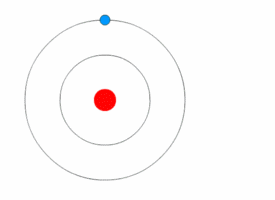Do objects gain protons to become positive?
This is part of a series on common misconceptions.
True or False?
Positively charged objects necessarily gained protons.
Why some people say it's true: We know that protons are positively charged particles, and therefore a positively charged object must have gained electrons.
Why some people say it's false: Protons are largely stuck in the nucleus and it is difficult for them to leave.
The statement is \( \color{red}{\textbf{false}}\).
Contents
The Argument
The answer to our question lies in the basics of the atomic structure. Atoms are made up of neutrons, protons, and electrons. Neutrons and protons are called nucleons because they make up the tightly bound nucleus of atoms. Electrons exist in clouds around the nucleus called orbitals. For our purposes, we can think of an atom using the cartoon model below.
 Simple model of an atom. The electrons can jump shells by releasing/gaining energy.
Simple model of an atom. The electrons can jump shells by releasing/gaining energy.
If an atom develops a positive charge, how could it have happened? It couldn't possibly have taken on additional protons because protons and neutrons are bound by the strong nuclear force, which keeps the nucleus stable.
Instead, we look to the loosely bound electrons. Electrons are not as tightly bound as nucleons and can be kicked out of the atom given sufficient energy. The ionization energy is the threshold energy required to kick out the most loosely bound electron in an atom, e.g. in the case of hydrogen, the energy required to make the \(\ce{H -> H^+}\) transition.
For an atom in the ground state, the number of protons is equal to the number of electrons so that the net charge is zero. But when an atom loses an electron, the number of protons becomes one greater than the number of electrons, so that the net charge is \(+1\, q_e.\) Thus the net charge of the ion will be positive. \(_\square\)
Note: It is possible for atoms to gain protons under certain conditions, like in a particle accelerator.